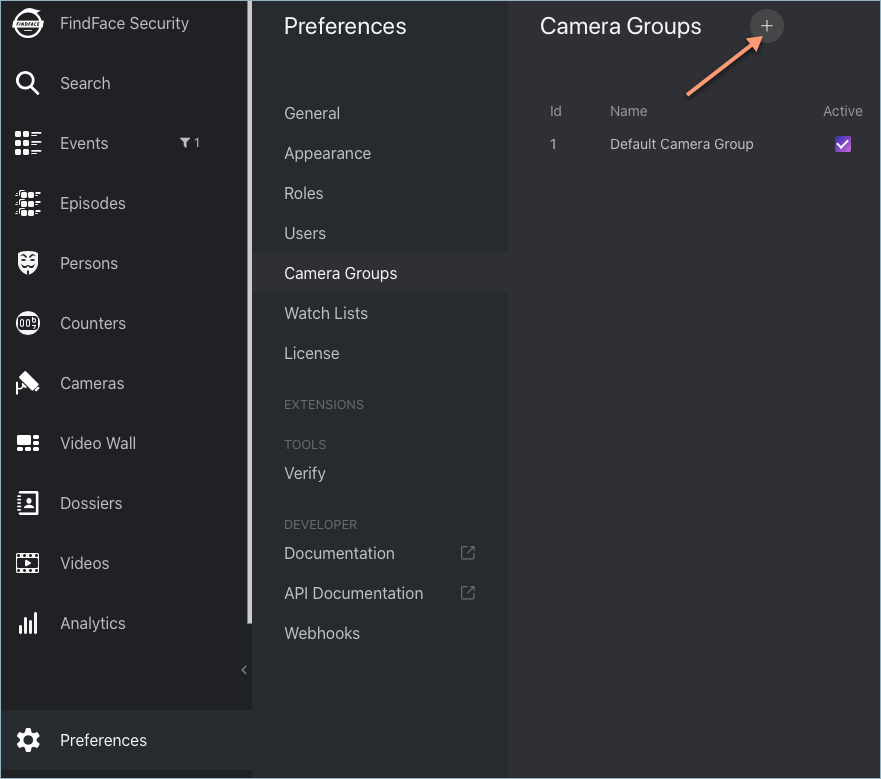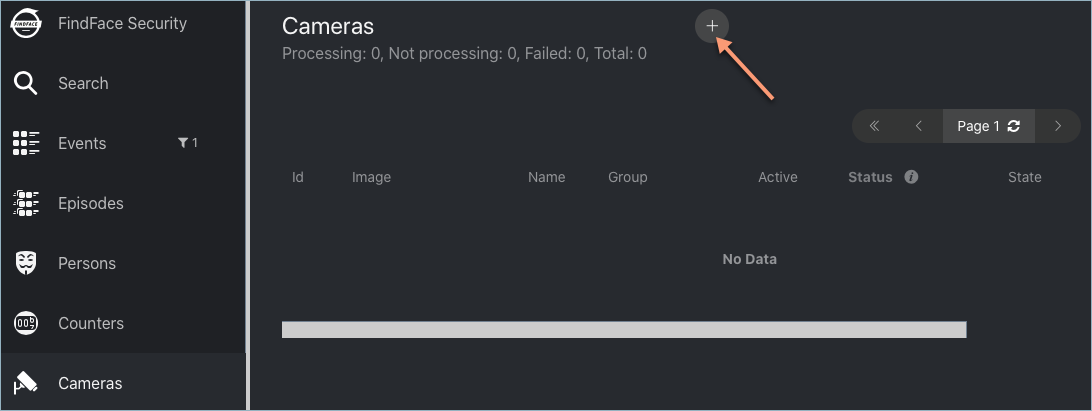Camera Management¶
To configure video-based biometric identification, add cameras to FindFace Security, grouping them subject to their location.
Note
Privileges to create camera groups and cameras are managed in user’s permissions (see User Management).
In this chapter:
Create Camera Group¶
Tip
A default preconfigured camera group is available in the system.
To create a group of cameras, do the following:
Navigate to the Preferences tab. Click Camera Groups.
Click +.
On the Information tab, specify the group name. Add a comment if needed.
If you want to allocate a certain
findface-video-workerinstance to process video streams from the group, create or select one or several allocation labels.Note
To complete the allocation, list the labels in the
findface-video-workerconfiguration file. See Allocate findface-video-worker to Camera Group for details.If you want to deduplicate events from cameras that belong to the same group, i. e. exclude coinciding events, check Deduplicate Events and specify the deduplication interval (interval between 2 consecutive checks for event uniqueness).
Warning
Use deduplication with extreme caution. If cameras within a group observe different scenes, some faces may be skipped. See Deduplicate Events for details.
By default, all camera groups in the system are applied the generic confidence threshold. To set an individual threshold for the camera group, check Confidence Threshold and specify the threshold value.
Important
The default generic confidence threshold is optimal for the majority of recognition cases. We do not recommend changing it on your own. Be sure to consult with our technical experts by support@ntechlab.com.
Check Active.
Click Save.
On the Permissions tab, assign privileges on the camera group, specifying which user roles are allowed to change/view the camera group settings.
Click Save.
Add Camera¶
To add a camera, do the following:
Navigate to the Cameras tab.
Click +.
Specify the name of a camera and add it to a group. If necessary, add a comment.
Specify the camera URL or path to the video file, for example,
file:///data/some.mp4.(Optional) Specify the camera geographical location.
By default, all cameras in the system are applied the generic confidence threshold. To set an individual threshold for the camera, check Confidence Threshold and specify the threshold value.
Important
The default generic confidence threshold is optimal for the majority of recognition cases. We do not recommend changing it on your own. Be sure to consult with our technical experts by support@ntechlab.com.
Check Active.
To configure video processing, click Parameters and make adjustments:
Minimum face snapshot quality (
filter_min_quality): Minimum quality of a face snapshot to post. Do not change the default value (0.45) without consulting with our technical experts (support@ntechlab.com).Minimum face size (
filter_min_face_size): Minimum face size in pixels to post. If 0, the filter is off.Maximum face size (
filter_max_face_size): Maximum face size in pixels in post.Compression quality (
jpeg_quality): Full frame compression quality.FFMPEG options (
ffmpeg_params): FFMPEG options for a video stream in the key-value format [“rtsp_transpotr=tcp”, “ss=00:20:00”].Offline mode (
overall_only): Offline mode. Enable posting one snapshot of the best quality for each face.Time interval (
realtime_post_interval): Time interval in seconds (integer or decimal) within which the face tracker picks up the best snapshot in realtime mode.Post first face immediately (
realtime_post_first_immediately): Iftrue, post the first face from a track immediately after it passes through the quality, size, and ROI filters, without waiting for the firstrealtime_post_intervalto complete. The way the subsequent snapshots are posted depends on therealtime_post_every_intervalvalue. If false, post the first face after the firstrealtime_post_intervalcompletes.Post best snapshot (
realtime_post_every_interval): If true, post the best snapshot obtained within each Time interval (realtime_post_interval) in realtime mode. If false, post the best snapshot only if its quality has improved comparing to the previously posted snapshot.Posting timeout (
router_timeout_ms): Timeout in milliseconds for posting faces.Retrieve timestamps from stream (
use_stream_timestamp): If true, retrieve and post timestamps from a video stream. If false, post the actual date and time.Add to timestamps (
start_stream_timestamp): Add the specified number of seconds to timestamps from a stream.Play speed limit (
play_speed): If less than zero, the speed is not limited. In other cases, the stream is read with the givenplay_speed. Not applicable for live streams.Region of Tracking (
ROT): Enable detecting and tracking faces only inside a clipping rectangle. Use this option to reduce the video face detector load.Region of Interest (
ROI): Enable posting faces detected only inside a region of interest.Tip
To specify ROT/ROI, use the visual wizard. First, create a camera without ROT/ROI. Then open it for editing and click Parameters. You will see the visual wizard appear.
If necessary, specify optional parameters for video processing. Click Advanced Parameters.
- Force input format (
ffmpeg_format): Pass FFMPEG format (mxg, flv, etc.) if it cannot be detected automatically. - Verify SSL (
router_verify_ssl): If true, enable verification of the server SSL certificate when the face tracker posts faces to the server over https. If false, a self-signed certificate can be accepted. - Minimum motion intensity (
imotion_threshold): Minimum motion intensity to be detected by the motion detector.
Click Save.
Note
Each created camera is associated with a so-called job, a video processing task that contains configuration settings and stream data and is assigned to findface-video-worker. This task can be restarted (see Monitor Camera Operation).
Monitor Camera Operation¶
To monitor the operation of cameras, navigate to the Cameras tab.
Camera statuses:
- Green: the video stream is being processed without errors.
- Yellow: the video stream is being processed for less than 30 seconds, or one or more errors occurred when posting a face.
- Red: the video stream cannot be processed.
- Grey: camera disabled.
Tip
You can configure the yellow and red statuses based on the portion of dropped frames and failed face postings. To do so, modify the following parameters in the findface-security configuration file:
sudo vi /etc/findface-security/config.py
FFSECURITY = {
...
# max camera frames_dropped percent
'MAX_CAMERA_DROPPED_FRAMES': {'yellow': 0.1, 'red': 0.3},
# max camera faces_failed percent
'MAX_CAMERA_FAILED_FACES': {'yellow': 0.1, 'red': 0.3},
...
}
For each camera, you will be provided with complete statistics such as current session duration, the number of successfully posted faces, the number of faces processed with errors after the last job restart, the number of frame drops, and other data.
Note
Each created camera is associated with a so called job, a video processing task that contains configuration settings and stream data and is assigned to findface-video-worker. This task can be restarted.
To restart a job, click  in the Action column. In this case, the number of errors will be reset to
in the Action column. In this case, the number of errors will be reset to 0.
With a large number of cameras in the system, use the following filters:
- Camera groups,
- Active,
- Status.





